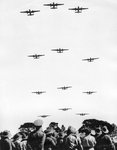Do like that Beau shot!
Navigation
Install the app
How to install the app on iOS
Follow along with the video below to see how to install our site as a web app on your home screen.
Note: This feature may not be available in some browsers.
More options
You are using an out of date browser. It may not display this or other websites correctly.
You should upgrade or use an alternative browser.
You should upgrade or use an alternative browser.
Picture of the day. (14 Viewers)
- Thread starter syscom3
- Start date
Ad: This forum contains affiliate links to products on Amazon and eBay. More information in Terms and rules
More options
Who Replied?vikingBerserker
Lieutenant General
When I see the first pic in post 1639 "The Flight of the Valkyries" runs through my mind.
If you ever wondered why so few ETO 8th Air Force airplanes made it back across the pond after the War... here's one of the answers...
These are the remains of U.S. Eighth Air Force B-17 Flying Fortress and B-24 Liberator bombers, based in Eastern England in WWII for the Strategic bombing of Germany and scrapped in situ at RAF Pulham, Norfolk, in 1947 instead of being ferried back to the U.S.A

Zoomable and further aerial views at:
Piles of scrap metal at RAF Pulham, Rushall, 1947 | Britain from Above
These are the remains of U.S. Eighth Air Force B-17 Flying Fortress and B-24 Liberator bombers, based in Eastern England in WWII for the Strategic bombing of Germany and scrapped in situ at RAF Pulham, Norfolk, in 1947 instead of being ferried back to the U.S.A
Zoomable and further aerial views at:
Piles of scrap metal at RAF Pulham, Rushall, 1947 | Britain from Above
Fascinating images on that link, abbadon1. Interesting to see Pulham's airship shed still surviving by the end of WW2. The station originally had two sheds, but in 1925 the other one was dismantled and moved to Cardington, Bedfordshire in support of the Imperial Airship Scheme. The airship R.100 lived inside it after completion at Howden whilst R.101 was housed in Cardington's original factory shed where she was built. Pulham had a distinguished RNAS career as an airship station; by far its most famous hour was the return of the British airship R.34 there on a direct flight from the United States in 1919. It had departed from East Fortune in Scotland and landed at Hazelhurst Field, Mineola Long Island, then back to Pulham St Mary.
fastmongrel
1st Sergeant
vikingBerserker
Lieutenant General
Is the prop tied to the truck to help stabilize the aircraft as they use the airbag?
Airframes
Benevolens Magister
No idea, been trying to work that one out myself. The truck is a AEC Matador fuel bowser, so it's heavy enough, but no idea what's going on.
fubar57
General
HMS Ark Royal, the day before she sank...

Geo
Geo
vikingBerserker
Lieutenant General
Such a beautiful ship.
Is the prop tied to the truck to help stabilize the aircraft as they use the airbag?
Looks like the aircraft isn't in the centre of the airbags, so it looks like it could slide off the back.
N4521U
Plastic Pirate
You could be right, looks like they slope to the back as well.
With the jack out front, it looks like they are going to raise the aircraft up sufficiently to install the jack under the wings - presumably there's also one on the other side, jack it up, then lower the undercarriage and if there is no damage to the gear, lower the aircraft onto its own wheels. The tanker looks like its there to steady the aircraft while air bags are being inflated. The flaps are down, so naturally the air bags can't be placed right under the wing; the flaps would get damaged as they couldn't take the strain of the air bags. Flaps would probably be inspected and retracted as well, depending on their condition. The air bags would be inflated only sufficiently to enable the jacks to be installed under the wings.
Last edited:
Airframes
Benevolens Magister
Yep, I believe you're right. The 'Matador' is taking the strain until there's enough clearance to get the screw jacks in position. As the engines/crank shafts have probably already been shock loaded, they wouldn't be that concerned about further possible damage caused by the stress of the ropes or cables. Engines and props can be replaced, the airframe is more important.
GrauGeist
Generalfeldmarschall zur Luftschiff Abteilung
A German Medic works alongside his American counterparts (seen to the far right) to assist with the treatment of wounded troops (wounded German seated) from both nations at an Aid Station in Saint-Malo, France

fastmongrel
1st Sergeant
I hope this is WWII as its a lovely photo

vikingBerserker
Lieutenant General
Very cool!
...and lovely!
great shots...
Wildcat
Major
fastmongrel
1st Sergeant
Static test of a Mk108 cannon firing mine shells against a Bristol Blenheim fuselage. If that had been a flying test the tail would have come off and the crew would be dead. Pity the picture is a bit poor quality I will keep looking for a better file.

Users who are viewing this thread
Total: 15 (members: 0, guests: 15)
Similar threads
- Replies
- 9
- Views
- 2K

